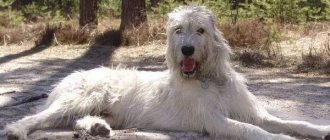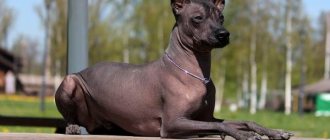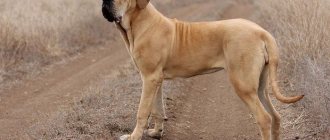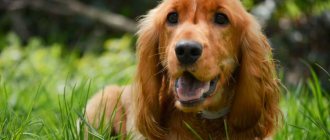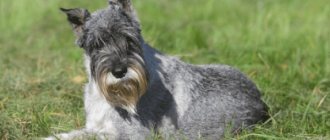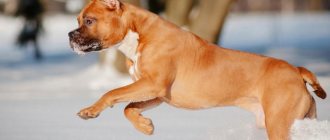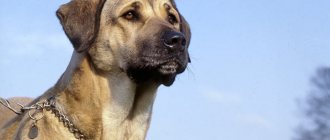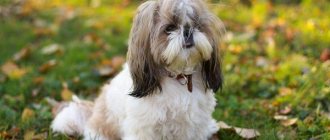The Belgian Shepherd is a dog that is popular all over the world. One of the varieties is the Malinois. This is an elegant, strong and hardy dog that is in demand in the police, security, Ministry of Emergency Situations, and the army. Thanks to their high intelligence and independence, these dogs help search for prohibited substances and missing people. They are loyal, affectionate, but suspicious and vigilant guards. Parenting needs to be taken seriously; not everyone can handle it. Therefore, before getting this breed, you need to study the features, pros and cons, as well as reviews from the owners.
- Varieties
- Head and muzzle
- Training and education of Malinois
- How to feed a Malinois
Breed traits
Breed traits (on a 5-point scale)
| Belgian Malinois | |||
| Activity | in the house | 3.6 | |
| on the street | 4.8 | ||
| Obedience | training | 4.8 | |
| strangers | 4.6 | ||
| Domination | in family | 3.2 | |
| over dogs | 3.6 | ||
| Defending your territory | from people | 3.4 | |
| from dogs | 4.2 | ||
| Sociability | in family | 5 | |
| with strangers | 3.4 | ||
| with dogs | 3.2 | ||
| Concentration | in family | 1 | |
| in front of strangers | 2.2 | ||
| with dogs | 2 | ||
| Aggressiveness | in family | 1 | |
| to strangers | 2.2 | ||
| to the dogs | 2.6 | ||
| to cats | 3.4 | ||
| Family behavior | calmness | 4.8 | |
| demand for affection | 4.6 | ||
| excitability | 4.4 | ||
| playfulness | 4.4 | ||
| excessive barking | 2.6 | ||
| behavioral breakdowns | 2.2 | ||
| Tolerance for children | up to 4 years | 4 | |
| over 4 years old | 4 | ||
| Institutional use | watchman | 4.6 | |
| bodyguard | 2.4 | ||
This breed is often compared to the following dog breeds: German Shepherd, Doberman Pinscher, Border Collie, Labrador Retriever, Rottweiler.
The photo shows what representatives of the Malinois dog breed look like:
Possible diseases
Dog handlers consider shepherds to be a relatively healthy breed. However, there are a number of diseases that occur in Malinois more often than others. The first group includes diseases of the musculoskeletal system, among which the leading ones are dysplasia of the elbow and hip joints. Intestinal problems such as bloating and bloating are common.
Neurological disorders include epileptic seizures. Among other things, Belgian Shepherd dogs often suffer from overweight and obesity. They are prone to allergies to both plants and food.
The eyes deserve special attention. Diseases such as cataracts, retinal atrophy and other diseases are common. By the way, this breed does not tolerate pain relief and anesthesia well. Therefore, the veterinarian must solve any problems that arise on an individual basis, with preliminary tests.
Description of the Malinois breed
Belgian Shepherds are a herding breed. One of the 4 types of national working dogs is the Malinois. This breed was developed only at the end of the 19th century, but based on the herding dogs common in Belgium. Particular attention was paid to her working qualities. Therefore, the Malinois is an excellent helper on the farm, a shepherd, a watchman, and a companion. For this dog, it is simply necessary to serve a person; without work and attention, it becomes aggressive and hot-tempered.
The Malinois is suitable for an experienced dog breeder who can pay enough attention to it and raise it properly. Then she will become a devoted friend, an obedient assistant and a faithful protector to him and his family members.
In appearance, the Malinois is a lean, muscular, harmoniously built dog with a proud posture. Its features are a narrow elongated muzzle with a black mask, triangular erect ears, short and thick yellow-brown fur. Moves easily and can change direction at high speed. Likes to run fast in circles and jump.
| Options | Characteristic |
| breed name | Belgian Shepherd |
| country of origin | Belgium |
| year of breed registration | 1891 |
| group of breeds according to the ICF classification | herding and cattle dogs, shepherd section |
| purpose of the breed | shepherd, service, companion |
| life expectancy | 12-14 years old |
| height | males 60-66 cm, females 56-62 cm |
| weight | males 25-30 kg, females 20-25 kg |
| character traits | smart, independent, hardworking, self-reliant, loyal, responsible, observant |
| attitude towards a person | loyal, affectionate, do not tolerate loneliness well |
| activity | requires a lot of physical activity, constant employment |
| training | lends itself well, but requires gaining authority |
| difficulty of care | unpretentious, easy to care for, but sheds all year round |
| health | good |
pros
The Malinois is the most sought after service dog in the world. She is hardy, efficient, and has excellent watchdog qualities. Often used for service in the police, army, security, rescue services, helps search for drugs and chemicals. She is considered the smartest dog, capable of making independent decisions in extreme situations. With proper upbringing, the dog will become a devoted friend, companion and protector. Representatives of the breed have many advantages:
- unpretentious, suitable for keeping in an apartment, country house, or on a plot;
- treat children well;
- very smart, quick-witted, have good memory and instant reaction, learn quickly;
- love fun games, intellectual activities;
- calm, balanced character;
- devoted, faithful, love the owner and his family members;
- have excellent watchdog qualities, vigilantly guard the owner and property, and bravely rush to defense;
- have good health, hardly get sick, remain active until old age;
- a good companion for travel, outdoor activities, sports;
- can be taught various complex tricks;
- one of the best breeds for service in the police, the Ministry of Emergency Situations.
Minuses
This Belgian Shepherd is not for everyone. It should not be owned by inexperienced owners, those who lead a sedentary lifestyle or cannot show strength of character. This pet needs to be given a lot of attention and time; without human communication and intellectual pursuits, it can become aggressive and uncontrollable. This is not a lap pet or a chain watch dog, but a dog for serious daily work.
The Malinois has several other disadvantages:
- requires constant attention from the owner and training;
- cannot stand loneliness, they can ruin an apartment out of boredom;
- suitable only for an experienced owner with leadership qualities;
- high physical activity required;
- may show aggression towards other animals if they did not grow up with them;
- suspicious of strangers;
- They are very active, jump high, so they can get injured.
An interesting video will tell you about the pros and cons of the breed:
Video: Malinois Shepherd Dog. Pros and cons of this breed.
Video: 5 Advantages of the Malinois breed!
Application of Malinois
Of all the Belgian Shepherds, the Malinois is the most common. These dogs have no equal in various sports - agility, modjoring, freestyle. They are superior to other breeds in speed, jumping, reaction speed, and the ability to make independent decisions.
Therefore, Malinois serve in the police, customs, and border troops. They are the best bloodhounds and rescuers, and can work as guide dogs. These dogs serve in hot spots and areas of natural disasters. They quickly look for explosives, drugs, people under the rubble.
It is not advisable to use Malinois as watchdogs. These dogs cannot be kept on a chain, they are very smart and should become a friend and helper to a person. They definitely need activities in which they demonstrate their ability to analyze, think, and make decisions. They love to search, recognize smells, and perform complex tricks.
History of the origin of the breed
At the end of the 19th century, a Belgian veterinarian decided to develop a national breed. She took as a basis the shepherd dogs that have long been common in Belgium. Medium-sized individuals with erect ears were used for breeding. This veterinarian and other dog breeders used the characteristics of local sheepdogs.
The breed was recognized in 1861, and a year later the first standard appeared. He clearly defined what kind of coat and color dogs should have. According to him, the Belgian Shepherd should be strong, muscular, but with an elegant physique. The main attention was paid to working qualities. These dogs are loyal, hardy, fast and very smart.
The Belgian Malinois variety was recognized as a separate breed at the beginning of the 20th century. The best representatives of local herding dogs were used in the selection. Particular attention was paid to their performance, endurance, and intelligence. Of all the Belgian Shepherds, the Malinois is the most popular due to its unpretentiousness and easy grooming. They spread throughout the world and became the best working dogs. In Russia, the Malinois shepherd dog is still very rare, and therefore expensive.
Varieties
From the very beginning of breeding, there were 4 varieties of Belgian Shepherds. According to the ICF classification, they belong to the same breed. But in some countries they are distinguished separately. The most famous in the world are Malinois and Groenendael. They differ only in color and coat characteristics. The varieties were named after the city in which they were bred:
- Groenendael - long-haired black shepherd;
- the Tervuren is also long-haired, but of a different color, with the obligatory black mask;
- Malinois - short-haired, yellow-brown in color with a black mask on the face;
- Laekenois is the rarest, wire-haired, ash-gray color.
Photos of different types of Belgian Shepherds:
Groenendael
Tervuren
Malinois
Laekenois
Difference from the German Shepherd
The Belgian Shepherd is less known than the German Shepherd. This is also a shepherd breed, but more independent, hardy, fast and unpretentious. The differences in appearance are small, but clearly noticeable. Belgian Shepherds have a more elegant build, a narrow muzzle, and black or fawn coloring. Depending on the variety, they may have either short or long hair.
German Shepherds have medium-length hair, a greater variety of colors, and a wide bone structure. In addition to external differences, one can note their poorer health, lower speed, and ease of training. Therefore, Malinois began to force them out of the police, army, security, and the Ministry of Emergency Situations. The Belgian Shepherd is more suitable for the role of a bloodhound, guide, or rescuer.
Breed characteristics and character
The Belgian Shepherd has four varieties - Malinois , Tervuren, Groenendael and Laekenois. The Malinois in this list is distinguished by such a characteristic as efficiency. The origins of the Malinois breed go back to the Flemish region, which is part of Belgium. The animal was bred, roughly speaking, by accident, using primitive selection, and was used as a shepherd.
Young Malinois Shepherd
Currently, the dog’s unique performance and other positive skills allow it to work in many special services - the army, police, and search units. In addition, the Malinois can work as a guide dog.
As a puppy, the animal is very active and curious, so it can cause a lot of trouble at home, from a torn curtain to a vase from the Ting era. On the street, a young dog tries to fall into a well or land in a hole. Amazing curiosity can last up to six months or later.
Therefore, the owner of the animal should be patient and try to direct energy in a productive direction. The Malinois Shepherd Dog is tolerant of members of its family, but can greet an unfamiliar guest with barking and aggression. This breed is not one of those who will wait for the “front” command. She will decide for herself when to raise her voice and roar.
Malinois on a walk in summer
This feature must be taken into account when raising a dog. Moreover, the four-legged friend needs very long training in the fresh air. The four walls of a house, especially if we are talking about an apartment, can ruin the dog’s character. If the dog is not socialized in time, he will begin to chase people on the street, cats, and even passing vehicles, accompanying his actions with loud barking.
For all its aggression, the dog reacts extremely sensitively to quarrels and scandals in the family and does not accept violence at all. The most you can do with a Malinois dog is to jerk the leash sharply.
Despite its complex and ambiguous disposition, this breed does not like to dominate and gets along with almost the entire family. Dogs treat children with restraint and will try to hide if the child goes beyond what is permitted. The Malinois perceives other canines neutrally if it is not suppressed.
Appearance of Malinois dogs
The FCI recognized the Malinois as a separate breed in 1956. At the same time, a standard was adopted that is still in use today. These dogs belong to medium breeds. Their physique is elegant and muscular. According to the standard, the height of Malinois reaches 66 cm, females are slightly smaller - 56-61 cm. And they weigh only 20-30 kg.
Head and muzzle
The head is set proudly, long, the back of the head is rounded, and the forehead is almost flat. The muzzle is slightly longer than the skull, tapering towards the nose. The bridge of the nose is straight, the nostrils are black and large. The stop is small, although clearly visible. The brow ridges do not protrude. The jaws are strong, the teeth are strong, the bite is scissor. The cheeks are flat, muscular, the lips are thin, black, and fit tightly.
The eyes are medium-sized, almond-shaped. The color is brown, preferably dark. The look is intelligent, lively, alert. The ears are triangular, erect, and set high.
Body Features
The neck is beautifully arched, long and muscular. It widens slightly toward the shoulders, and the scruff is smoothly curved. There should be no suspension, no folds either. The body is harmoniously built, the length of the body is approximately equal to the height at the withers. The physique is muscular and powerful, but the dog does not look heavy.
The chest is deep, the topline is straight, the belly is moderately tucked. The croup is wide, slightly sloping. The tail is medium length, thick. In a calm state, it is lowered, the tip is slightly raised. The dog never curls its tail or raises it above the line of the back.
Limbs
The limbs are straight, muscular, set parallel. The forearm is dry, slender, the forearms are long, the shoulder blades are set obliquely. The rear ones are powerful, standing perpendicular to the ground. The thighs are strong and wide, the shins are long. The paws are round in shape, the toes are tightly clenched, and the pads are thick. The dog moves springily, sweepingly and freely, jumping easily.
Malinois coat
The Malinois is a short-haired variety. The coat is thick, smooth, soft, with a dense undercoat. It protects the dog well from bad weather. The length of the fur is short, especially on the head. Longer length is acceptable on the neck, hips and tail. The color of the Malinois is monotonous. Only red or brown with black tan and a charcoal mask on the face are allowed.
Photos complement the description of the appearance:
Disqualifying faults
Belgian Shepherds can only be crossed with each other. Therefore, the standard has not changed much since the appearance of the breed. He clearly describes what these dogs should look like. Any deviation from the standard is not permitted. A dog may be disqualified for such deficiencies:
- not black lips, nose;
- light eyes;
- absence of a mask on the face or its asymmetrical nature;
- undershot or overshot;
- drooping ears;
- thin undercoat;
- coat that is too long or wavy;
- hook-shaped or short tail;
- different color, a lot of black;
- white spots on the body, they are only allowed on the fingers and chest;
- poorly defined muscles.
Breed standard
may look boxy in photos She has lean, strong muscles and a compact appearance. The length of the muzzle is either equal to or slightly longer than the proportional head.
The animal has a smooth transition from the forehead to the muzzle. It tapers towards the nose like a wedge, thin dry lips cover a row of strong, white, even teeth with a pincer-like bite. The jaws themselves are well developed and tightly closed. The dog looks at the world with almond-shaped, not too large brown or dark brown eyes, the gaze of which is direct, intelligent and slightly questioning.
The skull is of medium width, and in profile the top is parallel to the bridge of the nose. The nose is black, the superciliary ridges are outlined, but weakly, almost not prominent. Small, triangular, sensitive ears are set high and point forward when tense. The muscular neck widens towards the shoulders, it is slightly elongated and looks vertical.
The tail sits firmly at the base, is of medium length, hangs down to the legs when at rest, and rises when moving, but not above the horizon line. The dog has elastic, taut skin, and the short coat can vary in color.
The structure of the pile should be dense and the undercoat thick. The Malinois has a strongly defined "mask" with brow ridges or forehead on top and lips below. At the same time, the lips, ears and eyelids are black. The color of the breed is characterized by such a thing as “black overlay” - each individual hair has a black end, which seems to highlight the main color as a coating.
But spots or streaks are not allowed. White markings on the chest and toes are acceptable. With a weight of up to 30 kg, males grow up to 62 cm. The weight of females is up to 25 kg, and their height is 58 cm. Fluctuations in size are allowed by 2-4 cm in one direction or another.
Characteristics of the Malinois
The Belgian Malinois is an obedient and devoted pet. He needs a strict but loving owner who will pay a lot of attention. This breed is not suitable for busy or lazy people. To avoid problems, you need to study your character traits.
The dog will constantly follow the owner, try to please him, participate in all his activities and poke his nose everywhere. He should feel like a full member of the family. These dogs are ready to serve their owner all day long and protect him. Fans of the breed note their ability to predict a person’s desires, read thoughts and determine mood.
With proper upbringing, these are the most obedient and flexible representatives of Belgian Shepherds. Only a Malinois can turn around in a jump in the air at the command “fu”. They are affectionate, loyal, devoted, friendly. They get along well with all family members, including teenagers.
For a Malinois to have a good relationship with a small child, they must grow up together. These dogs are balanced, reserved and patient. They are used to herding sheep, and they treat children the same way. But they do not like disrespectful treatment; they will not tolerate having their tail or ears pulled or their toys being taken away. Therefore, small children should not be left unattended with a pet. But with proper upbringing of the dog and teaching the child the rules of behavior with a dog, it will become his best friend.
The Malinois also has the following qualities:
- observation;
- intelligence;
- independence;
- cheerfulness;
- ability to make decisions independently;
- sensitivity, ability to empathize;
- loyalty to a person;
- equilibrium;
- courage;
- the desire to dominate other animals.
The Malinois is not a calm pet. He will not lie on the couch; on the contrary, he is always looking for something to do. He needs at least 3 hours a day of active physical activity to expend accumulated energy. Otherwise he will throw it out at home. These pets are very active and playful, especially in puppyhood, that is, up to about 5 years.
Malinois are not aggressive, but they are wary of strangers. They have a highly developed instinct to protect their territory. Noticing a threat, the dog will fearlessly rush to defense. But it will never pursue a stranger or act contrary to the owner’s command. You should not have a Malinois as a watchdog. These dogs cannot live without work and intellectual activities. Without communication with the owner and stress, they are unhappy and can become aggressive, nervous and stubborn.
The photo shows the behavioral features and habits of these shepherds:
Malinois and Frisbee
Malinois in training
Malinois with a child
Malinois jump
Training and education of Malinois
This dog needs serious training, early socialization and constant attention from the owner. She is intelligent, very smart, has a good memory, but not everyone can cope with training. Therefore, you should not get this breed if you have no experience in raising a dog or time for a dog. The Malinois can easily be trained by an experienced owner thanks to the following qualities:
- performance;
- endurance;
- sharp mind;
- observation;
- lightning-fast reaction;
- good memory;
- stress resistance.
It is necessary to start training a Malinois from early childhood; in adulthood it will be impossible to re-educate him. Basic training should last up to 7 months, during which time stereotypes of behavior and habits are formed that remain with the pet for life.
After adapting to the new home, the puppy needs to begin to be introduced to the outside world. You need to learn to react normally to passing cars and strangers, not to rush at birds on the street, and not to be afraid of sharp sounds. Training with your baby should be done in a playful way, it should be interesting and not very tiring at first.
The owner must behave calmly, confidently, and not raise his voice. Rough treatment of the pet, aggression or physical impact is unacceptable. Malinois understand intonations and guess a person’s mood. If you gain the dog’s trust and become its friend, it will copy its owner’s behavior and become just as balanced.
You need to work with your pet for at least 2 hours a day. These dogs enjoy training. They are able to remember more than a hundred commands and easily learn various tricks. It is important that the training is not monotonous, otherwise your pet will get bored with it. It is recommended to constantly make the lessons more difficult. You can teach Malinois freestyle, agility, frisbee.
The video will complement the description of the characteristics of the breed:
Video: Top IMPORTANT facts about Malinois that you need to know. A dog is not for everyone!
Video: Belgian Shepherd Malinois. Experts talk about the breed
Alex Vyatkin. Owner. Philosophy of breeding "Vyatkins' Malinois". Vyatkins' Malinois have a strong character and love for their work. Good on/off balance, clear head and strong attachment to owner. Our line is designed to produce strong, healthy, reliable dogs that are especially excellent in protection and security functions for family life, work in the police and army, security agencies and personal protection, work in sports. We never spare any expense on the development of our breeding bases. We do not work with other breeders and do not sell dogs for breeding. Therefore, puppies - dogs with the prefix Vyatkins', which you will see in the photos and videos on our resource, can only be purchased at Vyatkins' Malinois.
Beware of fakes from those who use our name in their advertising. There are real and Chinese I-Phones...
If you purchased a dog not from Vyatkins' Malinois, but from the "blood of the Vyatkin kennel", then you have anything but Vyatkins', and the qualities described by the owners of our dogs may differ in many ways from the quality of your dog, since it was not was born according to the principles by which we produce our dogs...
When I think about priorities in breeding, I always put at the forefront the thing without which “Vyatkins' malinois” would turn into an ordinary “raspberry” - pretty with a dark muzzle, but terribly useless... So the list of priorities for me: 1. Health. Mental and physical. Because without it, the dog is not able to perform the functions listed below. 2. The ability and desire to resist someone else's. Without this, there is no and will not be in my lifetime Vyatkins malinois 3. The ability to distinguish between friends and others (clear head and balance). What does it mean? We love, listen and protect our own! Inadequate Strangers and idiots who believe that you can provoke someone else’s dog unrequitedly, fall on it drunk with impunity, grab it by the neck or grab a leash without asking, hit with a whip, yell at and grab the owner... - we eat without shyness... for a stranger is a stranger... and a fighter is fighter...every inadequate person has a Vyatkins Malinois as an opponent :) . Maybe a little harsh, but fair. 4. Balance of excitation - inhibition processes. The dog must be able to turn on and off. At work - we are on fire, striking sparks with our hooves... at home - a cat, a cute girl, a kisser... if it doesn’t calm down or doesn’t turn on, it’s an imbalance. 5. “Hardness” - the ability to endure physical and psychological correction/pain and move on without breaking down and even rejoicing!!! Go towards your goal no matter what. 6. Fighting drive - love of fighting. Remember Porthos and his famous: “I fight because... I fight!” 7. Genetic acumen 8. Drive and endurance... 9. Contact and the desire to work for a person (social instinct) 10. PS Don’t ask about the “standard” - centimeters, the amount of white and black, the shape of the tail... I honestly don’t know and don’t want to know, because the main parameters, the only ones important to me, are already listed above.
Features of maintenance and care
The Malinois is unpretentious and gets along well in any conditions. It is best to keep this dog in a private house with a large plot. The coat with a dense undercoat protects it from any weather. You can’t keep her on a chain; if the enclosure is large, it should be spacious. A warm booth and the ability to run freely are desirable. The area must be fenced with a fence no lower than 3 meters; this is exactly the height that these dogs can jump.
But a Malinois can live in a city apartment if you take it for a walk several times a day. You need to walk for at least 2 hours, and not just walk, the dog must run and play. If you provide your Malinois with sufficient exercise, he will be more comfortable in the house, since his owner is nearby.
It is not advisable to bathe your pet frequently; washing reduces the protective properties of the coat and can lead to dry skin and allergic reactions. Once every 3 months is enough. Dry cleaning several times a week is recommended. Brush weekly with a stiff bristle brush or a special rubber glove. And during shedding twice a year - every day with a comb with sparse teeth. It is very important to remove dead hairs in a timely manner; they can lead to the formation of tangles and skin inflammation.
You need to check and clean your pet's eyes and ears regularly. Claws are trimmed as they grow, unless they become worn down on the asphalt. It is better to use special bones for cleaning your teeth.
How to feed a Malinois
The dog's diet should be balanced. You can give natural food or high-quality dry food, just do not mix. Feed twice a day at the same time. Malinois are unpretentious eaters and are not gluttonous. But the choice of food must be approached responsibly. The diet should contain all the necessary vitamins, minerals, fatty acids, enough protein and carbohydrates.
If you choose ready-made food, you should give preference to premium or super-premium options. Suitable food for Malinois with a meat content of at least 30%: GO!, Orijen, Acana, Applaws, Brit, Grandorf, Farmina Natural & Delicious. It is advisable that they be marked Active or Sport.
When choosing natural feeding, you need to adhere to the following rules:
- 60% of the diet should be animal proteins: meat, offal, eggs, fish;
- 20-25% are cereals - oatmeal, buckwheat, rice;
- 10-15% – vegetables and fruits;
- You also need fermented milk products, vegetable oil;
- Additionally, on the recommendation of a doctor, give multivitamin supplements.
You cannot feed your Malinois river fish, pork, or food from your table. It is forbidden to give milk, sausages, smoked meats, flour products, potatoes, legumes, raw meat, tubular bones, and sweets. Your pet should always have clean, fresh water freely available.
Health
These dogs are in good health, have good immunity and few genetic diseases. If your pet is vaccinated on time and treated for parasites, he will live without disease and remain active until old age. And the life expectancy of these dogs is 12-15 years. But still, sometimes Malinois have the following pathologies:
- dysplasia of the hip or elbow joint;
- progressive retinal atrophy, cataracts;
- volvulus;
- epilepsy;
- dysfunction of the thyroid gland;
- allergic reactions;
- sensitivity to anesthesia and some other drugs.
Due to its high activity level, this dog is prone to injury. Malinois love to jump high and change direction at high speed, so they can injure joints and tendons. An excited, enthusiastic dog may not feel pain; it is important to carefully monitor it. And if you don’t exercise your dog physically, it will gain weight and become depressed.
Nutrition
As is the case with other breeds, Malinois puppies eat about 5-6 times a day. At three to four months, the number of servings is reduced by one per day, by six months the dog eats three times a day, and by one year of age - twice a day.
Malinois puppy
However, some breeders claim that already at six months the dog can eat only in the morning and evening. However, in practice this is not always the case. And don’t forget about the principle: reducing the number of meals means increasing the contents in the bowl.
You can easily find weight and height charts for dogs of this breed on the Internet. If the owner is worried that his dog is malnourished, he can use the data on the sign. Although usually the story is the opposite with Malinois, since the dog has a tendency to become obese.
Basic principles of eating:
- gradual weaning from the food that the breeder gave the dog;
- gradual introduction of new products into the diet if the dog is naturally fed;
- exact adherence to the feeding schedule on time;
- attention to the weight of portions;
- Regularly refreshing a bowl of clean drinking water.
Malinois boy age 3 years
There are three types of feeding, from which the owner will choose what suits him and the dog: natural, artificial (factory food), mixed. If everything is relatively clear with the mixed type, then the artificial type, which implies the use of dry food in the diet, must be of high quality. It is desirable if it is premium or extra-premium class.
Such food is not sold everywhere; for example, you rarely see it in a regular supermarket. But you can be sure that it will not harm the dog (Malinois is prone to allergies) and will be beneficial. The main advantage is saving time on cooking.
If the owner decides to cook for the pet himself every day, he will need to know the lists of allowed and prohibited foods. Many types of meat are allowed, such as beef, lamb, veal, poultry and even horse meat. You can boil it, you can crumble raw pieces into pieces, but you should avoid minced meat. Pork is prohibited due to its high fat content. Sea fish is also allowed as protein.
The preferred cereals are oatmeal, rice and buckwheat. The taste can be enhanced by cooking the porridge in rich meat broth. It is better to give vegetables locally, boiled or grated. Eggs are allowed a couple of times a week.
Allowed “fermented milk” includes natural yogurt, fermented baked milk, kefir and yogurt. The taboo list includes: river fish, garlic, onions, spices, baked goods and chocolate, spicy foods, salted and fried foods, sharp bones.
How to buy a Malinois puppy
Belgian dogs are rare breeds; they are not yet very well known in Russia. Therefore, it is best to buy a puppy from a large nursery. Then there will be a guarantee of purchasing a purebred dog without hereditary diseases. The price of a purebred Malinois is at least 30-50 thousand rubles. A mixed breed or a puppy without a pedigree can be bought for 10-15 thousand.
Puppies are sold at 2-2.5 months. By that time, shortcomings in behavior and appearance, if any, are already noticeable. When choosing, you need to pay attention to the parents, their behavior, and the conditions in which the dogs are kept. The puppy must be active, not cowardly, not aggressive. The fact that he is healthy can be determined by the condition of his coat and eyes. The skin should be clean, the eyes and ears should be free of discharge, the coat should be smooth, without bald spots or dandruff.
Photos of puppies:
Malinois puppies
Puppy
Malinois puppy
Before getting a Malinois, you can watch a video about its features:
Video: Belgian Shepherd Malinois - All about the dog breed
Video: Should you get a Malinois? Working dog experience! Pros of the Belgian Shepherd!
The Malinois is the best working dog. It is not recommended to have one to protect your home or as a pet. This is a serious dog that will become a devoted companion and faithful friend to an active sports person. It is not suitable for inexperienced owners, as well as people who do not have time to raise and communicate with their pet. Malinois is a serious choice, a big responsibility. But with the right approach, she can give a lot of love and joyful moments.
Price
The price of a Malinois depends on many factors: the place of purchase, the gender of the dog, the purpose for which the dog is purchased, the availability of documents, including medical ones. The place of purchase is perhaps one of the most important points when making a transaction. The future life of both the owner and the pet depends on where to buy the dog.
An animal purchased from a poultry market will not have a good reputation in terms of health. Most likely, it will be painful, and if not, it will only partially resemble the breed. Without documents, any dog automatically becomes a mixed breed or mongrel.
Purchasing from an official private breeder is a better option. In this case, you can receive a certificate of breed membership and pedigree. But private breeders set the price themselves, and it may not be very acceptable.
The best option is a Malinois nursery. The cost of dogs here starts from $500, depending on the purpose of the purchase. The “simpler” option is the pet class, which will be a family favorite and a companion for the owner.
Breed standards prohibit breeding him. He is also not allowed at exhibitions. At the same time, representatives of the pet class have all the necessary documents, including a guarantee that they are purebred.
And if we are talking about a show-class dog, then you should not expect prices lower than 50-60 thousand rubles. But we can assume that the dog will win medals at exhibitions. In addition, you can offer it for mating on financially favorable terms.


